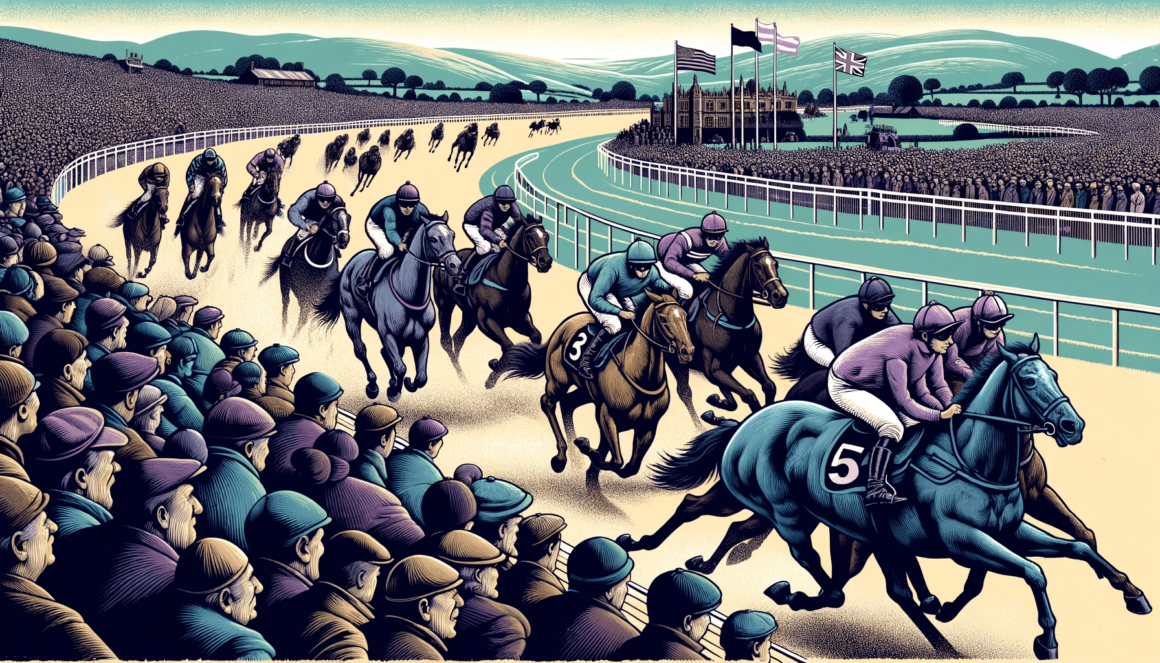21 Horse Racing Facts & Stats To Know About Before Going to the Tracks
Horse racing is a popular sport in many countries. Millions of people go to horse races every year to watch the thrilling action and place bets on their favorite horses.
If you’re interested in learning more about horse racing, read on for some fascinating horse racing facts about this exciting sport.
History of Horse Racing

If you are wondering where horse racing originated, Google no further. Here are some interesting facts about the sport’s origins and early days, including where it started and how it became the sport we all adore watching today.
1. Horse Racing originated around 4500 BC in Central Asia.
(Science.org)
So, where did horse racing originate? Central Asia and Euroasia are credited with domesticating horses 6000 years ago. More precisely, West Kazakhstan and modern-day Ukraine. It was not long after horses were first domesticated that horse racing became a thing.
2. Chariot racing popularized the sport in Europe and Africa in 1000 BC.
(PetKeen)
Horse racing saw many variants and modifications over the years. One interesting addition was adding chariots, which became popular in ancient Greece around 1000 BC. At the time, athletes raced horses with chariots or two-wheeled carts. Romans became huge fans of the sport, while Egyptians not only used horse-drawn chariots for sporting events but in battle as well.
3. Horse racing became an official sport in 664 BC.
(PetKeen)
The 33rd Olympiad in 664 BC is an important event in horse racing history – it was for this event that horseback racing was named an official sport. Horse riders became known as jockeys at the time, and the name stuck today.
4. Romans brought horse racing to Britain in 200 AD.
(HorseRacingSense)
As horse racing flourished across the Roman Empire, it found its way to the UK. Historians estimate that it was introduced to Britain in the common era. It was quickly adopted and became one of the most popular sports, which it still is today.
But, how long has horse racing been around in the UK officially? The first documents about horse racing didn’t appear until 1679. The London Gazette was the first to report on and document a horse race.
Horse Racing in the UK
Horse racing is a long-time favorite pastime of many Brits, and its long history brought us many interesting facts about the sport that was later brought to the US. Let’s dive in.
5. Horse Racing is the second-most-watched sport in the UK.
(Racing Explained)
When it comes to the number of viewers worldwide, soccer is the most popular sport. This stands true for the UK as well. However, with approximately six million attendees at racecourses throughout the year, horse racing figures clearly show that Brits love horse racing almost as much as they love “footie.”
6. The sport is often called “The Sport of Kings” due to King James I.
(Horsey Hooves)
We’ve all been there, so encapsulated with our video game, book, movie, or sports event that we forgot what we were supposed to do. For King James I, the video game addiction was horse racing. It got such a grip on him in 1605 that he forgot how to be a responsible monarch. The Parliament had to act and remind him of his duties as a king way too often.
He established Newmarket as a resort, and his son James II named it the headquarters of British racing. It was all about horse racing at the English court in those days, so it soon became known as the “Sport of Kings.”
7. Queen Elizabeth’s horses brought home more than 1,600 wins.
(Horsey Hooves)
The tradition of horse racing’s popularity didn’t end with James II. It is no secret that Queen Elizabeth has a great interest in horses and is an avid horse racing fan. She has owned many racehorses, which won more than 1,600 wins over the years. She even has three different horse races named after her.
Her daughter, Princess Anne, has taken the love of horse racing to the next level. Princess Anne was the first Royal to compete at the Olympic Games in 1976, penning her name in the history of horse racing. Even though she didn’t take home an Olympic medal, she has a gold medal from the 1971 European Championships.
The queen’s granddaughter, Zara Tindall, also followed in her footsteps, winning a silver medal at the 2012 Olympics.
8. Horse racing in the UK contributes over 3.7 billion to the local economy.
(Racing Explained)
Racing is a billion-dollar industry but also a popular gambling sport. Approximately $100 billion are bet on horse races annually in the UK alone. Horse racing industry statistics show that the sport and its popular events contribute over £3.7 billion to the economy.
9. Horse race tracks differ significantly in shape between the UK and US.
(Horse Racing Sense)
Horse race tracks vary significantly in Europe and USA. English tracks are not as standardized as American ones, which are typically oval and flat. Instead, they may be pear-shaped, U-shaped, or triangular, among other variations.
Furthermore, horse races are run clockwise in England and counter-clockwise in the USA, which is just one of the interesting facts about horse riding differences. As far as the US is concerned, this trend started in 1821.
Until then, Belmont Stakes, for example, was run clockwise – just like in the UK. The main reason for the change was that it made it easier for the righties.
Horse Racing in the US
Horse racing is one of the most popular sports in the United States. It has a long and rich history and is a beloved pastime for many people. So, when did horse racing start in the US? What are some interesting facts you might not know about the sport? Let’s find out.
10. Horse racing in the US officially dates back to 1665, but new evidence suggests it has been around for much longer.
(PetKeen)
There is a well-known trope that Columbus brought the first horse to America in the 15th century, and the first racetrack in colonial America was built in the 1600s on Long Island.
However, new evidence is coming to light to dispute this theory and prove that horses have been native to the States long before that. It could suggest that horse racing in the US started long before Columbus was even born.
Until we have clearer proof, though, the origins of horse racing in the US are linked to the same man as those in the UK – King James I, the founder of the famous Newmarket course.
11. By the beginning of 1890, the US had 314 tracks operating.
(HorseyHooves)
Horse racing in the US had a rocky start. It was, at the time, a very hectic sport, and on top of it, it was poorly organized. However, due to its popularity, more and more prominent racehorses were brought to America from England for breeding and creating champion racers. This only added a new level of popularity to the sport, which became a genuine phenomenon by the end of the 19th century.
12. Horse betting was legalized in the US in the 1900s to stimulate the economy.
(PetKeen)
Despite this change, the first half of the 20th century was tough for the sport. One of the most notable horse racing facts of the period was that the two world wars, especially WWII led to a massive drop in interest in horse racing.
Before WWI, though, the betting industry was flourishing in this sector. Kentucky was the first to jump on board in 1906, formally legalizing the betting system for pari-mutuel horse racing. It was followed by New York and Maryland not long after.
Today, we have 40 different states with defined jurisdictions and legalized horse betting in the US. Now that the US Supreme Court has legalized it, betting on horse races will undoubtedly start boosting sports betting numbers across the country.
13. Horse racing is a multi-billion-dollar industry in the US.
(Horsey Hooves)
According to the horse racing industry statistics, the US economy benefits approximately $36.6 billion from horse racing every year. It also employs around 472,000 people, including jockeys, trainers, and racetrack food workers, so its impact on the economy and job market is significant.
14. The Kentucky Derby is the most prestigious horse racing event in the US.
(PetKeen)
The Kentucky Derby, (not to be mixed with soccer derbies) a horse racing event with long history and tradition, marked its 147th annual running in 2021. Founded in 1875 as an attempt to be a US counterpart to Epsom Derby in England, horse racing statistics show it to be the most prestigious event in US horse racing. This “grandest sporting event of the year” sees its tracks packed with people from all over the globe, and millions more watch it on TV.
15. The Kentucky Derby has its own song and drink.
(PetKeen)
Here’s one of the more interesting facts about horse riding: there’s a race with its own theme song and drink.
It is only expected that an event that has been running for almost 150 years has its long-standing traditions. The Kentucky Derby has Mint Juleps – a fancy drink that spectators enjoy before, during, and after the race. This official Kentucky Derby drink is made of mint, sugar syrup, and bourbon.
Mint Juleps is accompanied by the official Kentucky Derby song. It is called “My Old Kentucky Home” and is performed by Stephen Collins Foster. Spectators can not only place bets about racehorses’ chances for the grand win but also on how long the song will be played. No drink-related bets, though, sadly.
Thoroughbreds and Racing Horses – Stats and Facts
Now, let’s talk about the most important aspect of horse racing – the horses. Here are some fun facts you should know about these majestic beasts.
16. All thoroughbreds in the northern hemisphere share the same birthday – January 1st.
(Horse Racing Sense)
An interesting practice, which started in England, states that all horse birthdays should be on January 1. During the early days, matching horses of similar ages wasn’t a requirement, which swayed horse racing statistics in favor of younger and stronger horses, who got an unfair advantage over others in the race.
In order to combat this practice, age limits were introduced, which is why a birthday date was set.
The first date recommended was May 1st, as the races in the UK typically start in the spring. However, January 1st made more sense due to the breeding cycles of the mares, which begin shortly after the new year for the Northern Hemisphere. Given the 11-month pregnancy that mares have to endure, it was the most logical date to choose.
Another interesting fact about racehorses is that their breeding cycle is different in the Southern Hemisphere, so all horses celebrate their birthdays on August 1st. As with England, the US initially followed the May 1st rule but changed the date to January 1st after the Civil War.
17. When at rest, the heart of a racehorse beats only 40 times per minute.
(Racing Explained)
Compare this to the human heart, which beats between 60 and 100 times per minute when resting. Clearly, horses can pace themselves better, which comes in handy considering the stress their hearts go through during the races.
Speaking of hearts, Secretariat, one of the most famous horses ever to race, had one that weighed an astonishing 22 pounds. Compared to the average size of around 9 lbs, he had a big heart indeed. While we’re not sure if it was the deciding factor in his spectacular career, the heart certainly became one of the most talked-about horse facts among horse lovers.
18. All thoroughbreds share the same ancestors.
(Horse Racing Sense)
All thoroughbred horses have to come from a purebred dam and sire. The ancestry of all thoroughbreds can be traced back to the three stallions imported to the UK from the Middle East in the 17th and 18th centuries. The three founding stallions were Byerley Turk, the Darley Arabian, and the Godolphin Arabian. They were, unsurprisingly, bred for war overseas as they were fast and powerful horses.
19. Only nine colors are recognized in thoroughbred horses.
(Horses Only)
Bay, black, gray, brown, and chestnut are the most common colors resulting from careful breeding. However, roan, palomino, and white are also recognized. One of the funny horse facts is that white markings on horses (regardless of their base color) also have a name – they are sometimes referred to as chrome.
20. The most expensive horse ever sold was worth $70 million.
(Horse Racing Sense)
Fusaichi Pegasus holds the record for the most expensive horse ever sold. It was initially sold for $4 million as a yearling, skyrocketing to $70m after winning the Kentucky Derby. It was purchased by Coolmore Ireland, who managed to outbid Sheik Mohammed of Dubai.
21. There are about 500,000 horses thoroughbred horses worldwide.
(Horses Only)
Racehorse stats show us that around half of those are based in the United States. There was a notable surge in the thoroughbred population in the 1980s, but things have since normalized to a more sustainable number as breeding rates have slowed down.
Not all thoroughbreds are racehorses, even though they are all still bred to run. Their racehorse training makes these horses perfect for other sports disciplines, such as jumping, fox hunting, polo, and dressage.
FAQ
What percentage of horses win a race?
If you need some horse racing winning odds statistics to help you make an educated bet, you should know that public betting favorites win approximately 33% of all races. However, 53% of the time, they end up second.
Second favorites win 21% of the time but finish second 42% of the time. Third choices will win approximately 14% of the yearly races. These percentages remain constant year on year, with slight short-term variations.
What number horse wins most often?
According to Equibase, horses wearing the number five won almost 13% of all races throughout the last ten years. While far from being a safe bet, this percentage is significantly higher than for any other number.
What stats are important in horse racing?
When it comes to horse racing facts, numerous ones can be used to evaluate a horse’s performance. The most important stats are the horse’s win percentage and average speed.
It’s also worth looking at the horse’s jockey statistics, though. Before making an educated bet, you need to better understand a horse’s strengths and weaknesses and all of the factors that might have an impact on its performance.
 BC.Game
BC.Game  7Bit
7Bit  Ducky Luck
Ducky Luck  Red Dog
Red Dog